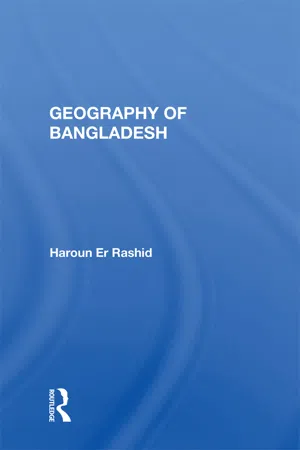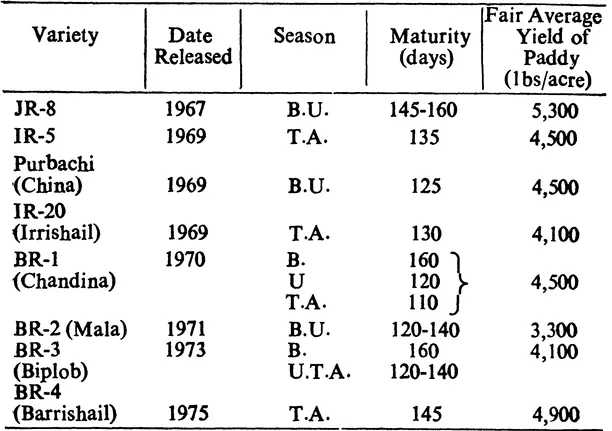![]()
Chapter X
Agricultural Products
Agriculture is of paramount importance to Bangladesh. Nine-tenths of the people depend, directly or indirectly, upon it. Over half of the National Product is from the agricultural sector. The great importance of agriculture and agricultural products is often not fully understood because of the pre-occupation with ways and means to promote industrial growth. Even if Bangladesh is substantially industrialised,it will remain very largely dependent upon agriculture, not only because there is not sufficient scope to become highly industrialised, but also because much of the industries must be based upon agriculturally produced raw materials. Moreover recent experience has shown that an excessive dependence on outside sources for basic foodstuffs can impinge on national sovereignty.
The importance of the agricultural sector has been stressed in this work because it is dominant in the economy. Agriculture will remain the basis of Bangladesh's economy for a long time to come, and the only way to improve the lot of the majority of its people will be to improve agricultural productivity.
In this Chapter all the major crops have been considered in some detail. It is upon the producton of these that seventy million people of this land depend.
Rice
Rice dominates agriculture in Bangladesh. It occupies 80% of the gross cultivated areas and constitutes 75% of the total produce from all field crops. It is not surpirsing, therefore, that the economy of Bangladesh is guided by he fluctuations in its price.
On an average about 21 million acres are under rice cultivation, including multiple cropping. This vast acreage gives Bangladesh an important position amongst the rice growing countries. She accounts for 9% of the world acreage and 9% of the world production. Only China and India have more land under rice, and only these two countries and Japan surpass her production.
Almost all the rice grown has been classed as Oryza sativa form spontanea (Grist, 1959). The floating rice most probably evolved from Oriza fatua. This rice, as well as O. minuta, O. officinalis, O. coarctata and others are found wild in Bangladesh, and many scholars consider the lowlands of Bengal as the origin of cultivated rice. However, genecological analysis by Morinaga (1968) suggests that the Darjeeling-Sikkim Himalayan Zone may have been the original dispesrsal zone for the cultivated rice. Morinaga found that Asian rice could be differentiated into four distinct ecospecies: Japonica, bulu, aus and aman. Ecospecies aman includes ecotype aman and boro from Bengal and chereh from Indonesia. Aus shows medium to high fertility with all ecotypes and the aus grown in the Hill Tracts is probably similar to the types grown in the sub-Himalayas. Rice cultivation may therefore have begun in the hills of the Assam-Bengal area and been carried into South-east Asia through the migration of the proto-Mongoloids
There is a certain amount of confusion about the exact meaning of the words paddy and rice. Paddy is the unhusked, and rice the husked, grain Paddy naturally weighs more. The usual conversion rate from paddy to rice is 66 percent; that is to say,rice is considered to be 65 percent of the weight of the paddy. Paddy is often called rough rice and rice is more clearly named as cleaned rice. The figures of rice yield mentioned in various Government publications often do not make clear whether they mean paddy or rice. Yields are usually stated in terms of rice.
The Bengali nomenclature for the growing plant and the grain is distinctive. Rice when in seed is called Bij or Chon; when it germinates, Ankur; the young plant is Jawali; the full grown plant Dhan-gach; just before it is in ear, Thor; when in ear, Phula; when the ear is empty, Chita; uuhusked paddy is known as Dhan; uncooked rice as Chal and cooked rice as Bhat.
Since the spread of dwarf, high yeilding varieties (HYV's) in the late 1960's there are seven main and three minor genotypes of rice in Bangladesh. They are Shail HYV Aman, JaliamonHYV Aus, Local Aus, Hill Aus, Local Boro, HYY Boro, Rayada and Bhadoi. These groups are differentiated by their varieties, thier plant size and yeild, their topographical requinnents, and their havesting time. Shail, HYV Aman and Jaliaman are classed as the Aman group. Rayada rice, grown in a few places in the delta region, is also classed as Aman. HYY Aus, local Aus and Bhadoi are classed as Aus. Boro both local and HYV, is a class by itself.
High Yielding Varieties
The most significant recent development in agriculture has been the introduction and spread of various high-yielding varieties (HYV's). These varieties are usually dwarf, and owe their origin to crosses between the short japonica type and the taller indica type. The first HYY to spread widely was IR-8, introduced in 1966. The initials are derived from the International Rice Research Institute (IRRI) at Los Banos in the Philippines. Since 1970 the HYV varieties released to the farmers are the result of breeding and selection at the Bangladesh Rice Research Institute at Joydebpur. The table (227p) lists the HYVs relased till 1975. One variety not listed is Pajam, a Malaysian cross, which has not been accepted by BRRI as suitable for release, but has proved successful with farmers in the eastern districts. It is medium to high yielding and taller than most HYVs. About 4 million acres are grown to HYYs, including Pajam. Of this HYY aman is grown on 2 million acres, HYV Boro on 1.5 million acres and HYV aus on half a million acres. Whereas, Boro HYVs are all irrigated, most of the HYVs in Aman and Aus seasons are grown in rainfed conditions. Statistics on area grown to HYVs are approximate, with the possibility of overestimation.
Table 10.1a HIGH YIELDING VARIETIES OF RICE
B=Boro; U=Aus; T.A.=Transplanted Aman.
The non-HYV groups consist of many varieties, most of which are based upon whether the grain they yield is fine, medium or bold. This quality in the grain is determined by the proportion of its roundness to its length. When the length to width rat...

